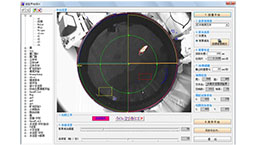Mouse Model for Peripheral Vestibular Disorders (PVD)
- Product No.DSI657Mu01
- Organism SpeciesMus musculus (Mouse) Same name, Different species.
- Prototype SpeciesHuman
- SourceInduced by total resection of labyrinth or vestibular nerve section
- Model Animal StrainsBalb/c Mice(SPF), healthy, male, age: 4~6weeks, body weight:18g~20g
- Modeling GroupingRandomly divided into six group: Control group, Model group, Positive drug group and Test drug group.
- Modeling Period4-6 weeks
- Modeling MethodWeight about 200g rats and weight about 500g guinea pigs, the examination of the external auditory canal cleaning, tympanic membrane integrity, no spontaneous nystagmus, hearing sharp. Guinea pigs were fixed with halothane, and the chemical method was used to disrupt the side of the labyrinth. The skin of the temporal area was exposed to sterile surgery and exposed to the tympanic membrane. A 0.5 mm hole was drilled with a scalpel. Chloroform into the Chinese ear cavity, but also by tympanic membrane puncture injection. Rats were treated with intramuscular injection of pentobarbital sodium (20mg/kg body weight) and ketamine (60mg/kg body weight). Then, the rats were disrupted by mechanical method. The bone marrow was cut off with bone clamp, Under the microscope, the round window membrane was aseptically cut, exposed to the balloon at the end of the cochlea, and the balloon was sucked with a miniature aspirator, the oval capsule and the ampullary ridge were wound and the wound was wound. Postoperative observation of the behavior of the model. After the end of all the experiments, anesthesia with pentobarbital sodium, the rats and guinea pigs for thoracotomy, exposure to the heart, the left ventricular incision to the aortic intubation, with 0.5% sodium nitrite temperature of saline and dissolved in The 10% formaldehyde solution in the phosphate buffer was perfused and the animals were sacrificed. The temporal specimens were removed and the histopathological changes were observed under microscope. Morphological changes of the vestibular structure were observed under microscope
- Applicationsn/a
- Downloadn/a
- UOM Each case
- FOB
US$
For more details, please contact local distributors!
Model Evaluation
Pathological Results
Cytokines Level
Statistical Analysis
SPSS software is used for statistical analysis, measurement data to mean ± standard deviation (x ±s), using t test and single factor analysis of variance for group comparison, P<0.05 indicates there was a significant difference, P<0.01 indicates there are very significant differences.
GIVEAWAYS
INCREMENT SERVICES
-
 Tissue/Sections Customized Service
Tissue/Sections Customized Service
-
 Serums Customized Service
Serums Customized Service
-
 Immunohistochemistry (IHC) Experiment Service
Immunohistochemistry (IHC) Experiment Service
-
 Small Animal In Vivo Imaging Experiment Service
Small Animal In Vivo Imaging Experiment Service
-
 Small Animal Micro CT Imaging Experiment Service
Small Animal Micro CT Imaging Experiment Service
-
 Small Animal MRI Imaging Experiment Service
Small Animal MRI Imaging Experiment Service
-
 Small Animal Ultrasound Imaging Experiment Service
Small Animal Ultrasound Imaging Experiment Service
-
 Transmission Electron Microscopy (TEM) Experiment Service
Transmission Electron Microscopy (TEM) Experiment Service
-
 Scanning Electron Microscope (SEM) Experiment Service
Scanning Electron Microscope (SEM) Experiment Service
-
 Learning and Memory Behavioral Experiment Service
Learning and Memory Behavioral Experiment Service
-
 Anxiety and Depression Behavioral Experiment Service
Anxiety and Depression Behavioral Experiment Service
-
 Drug Addiction Behavioral Experiment Service
Drug Addiction Behavioral Experiment Service
-
 Pain Behavioral Experiment Service
Pain Behavioral Experiment Service
-
 Neuropsychiatric Disorder Behavioral Experiment Service
Neuropsychiatric Disorder Behavioral Experiment Service
-
 Fatigue Behavioral Experiment Service
Fatigue Behavioral Experiment Service
-
 Nitric Oxide Assay Kit (A012)
Nitric Oxide Assay Kit (A012)
-
 Nitric Oxide Assay Kit (A013-2)
Nitric Oxide Assay Kit (A013-2)
-
 Total Anti-Oxidative Capability Assay Kit(A015-2)
Total Anti-Oxidative Capability Assay Kit(A015-2)
-
 Total Anti-Oxidative Capability Assay Kit (A015-1)
Total Anti-Oxidative Capability Assay Kit (A015-1)
-
 Superoxide Dismutase Assay Kit
Superoxide Dismutase Assay Kit
-
 Fructose Assay Kit (A085)
Fructose Assay Kit (A085)
-
 Citric Acid Assay Kit (A128 )
Citric Acid Assay Kit (A128 )
-
 Catalase Assay Kit
Catalase Assay Kit
-
 Malondialdehyde Assay Kit
Malondialdehyde Assay Kit
-
 Glutathione S-Transferase Assay Kit
Glutathione S-Transferase Assay Kit
-
 Microscale Reduced Glutathione assay kit
Microscale Reduced Glutathione assay kit
-
 Glutathione Reductase Activity Coefficient Assay Kit
Glutathione Reductase Activity Coefficient Assay Kit
-
 Angiotensin Converting Enzyme Kit
Angiotensin Converting Enzyme Kit
-
 Glutathione Peroxidase (GSH-PX) Assay Kit
Glutathione Peroxidase (GSH-PX) Assay Kit
-
 Cloud-Clone Multiplex assay kits
Cloud-Clone Multiplex assay kits
| Catalog No. | Related products for research use of Mus musculus (Mouse) Organism species | Applications (RESEARCH USE ONLY!) |
| DSI657Mu01 | Mouse Model for Peripheral Vestibular Disorders (PVD) | n/a |





